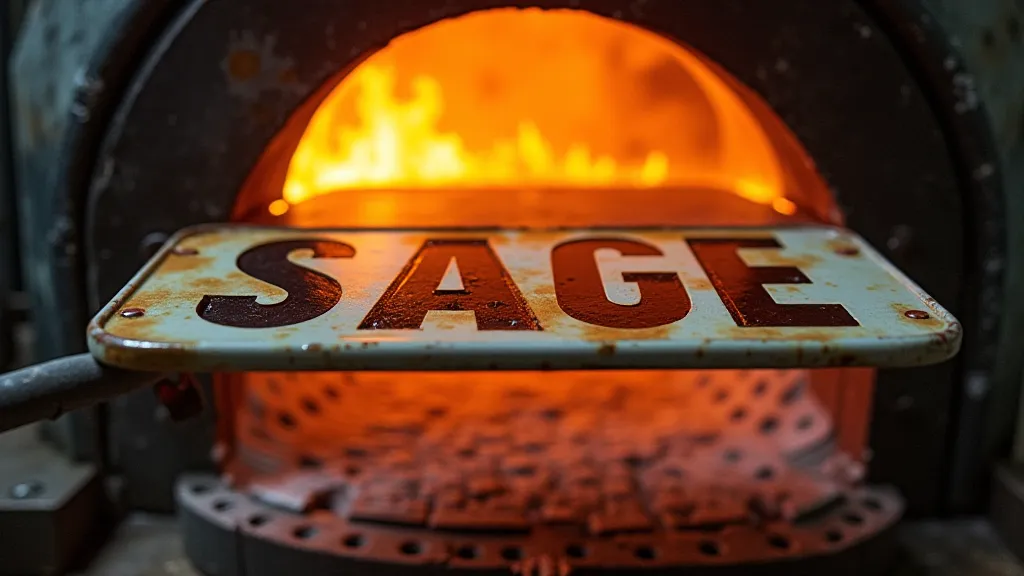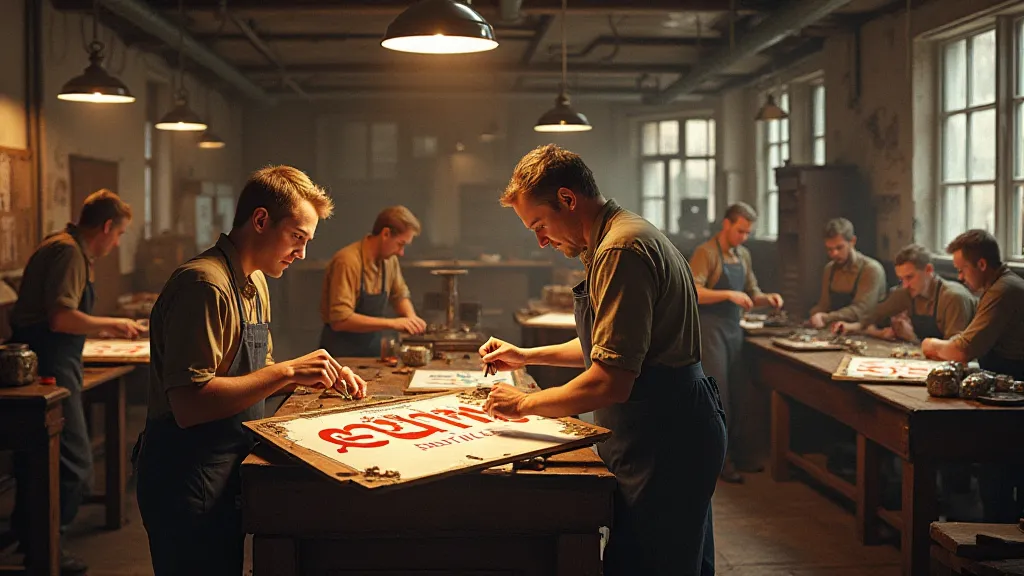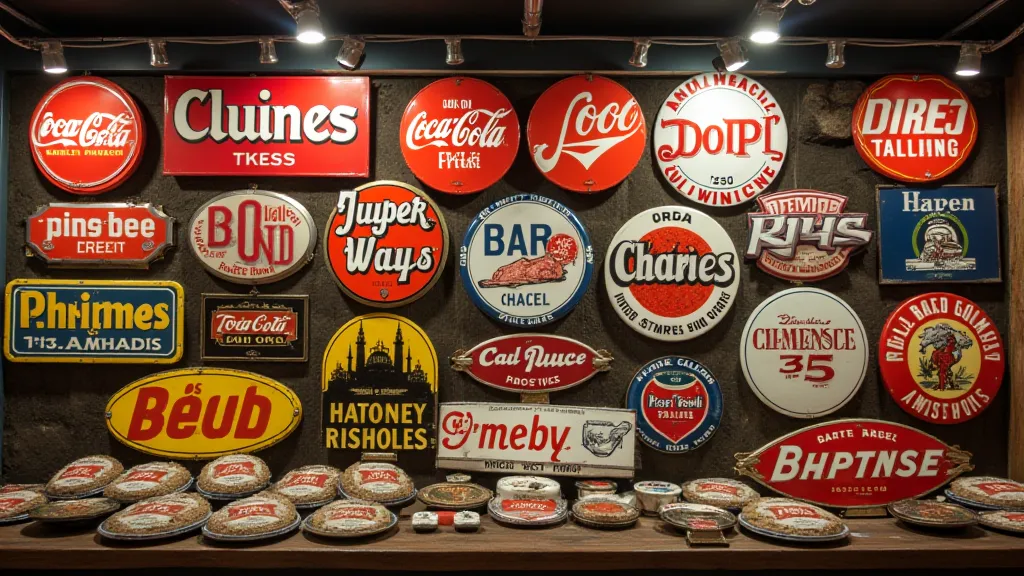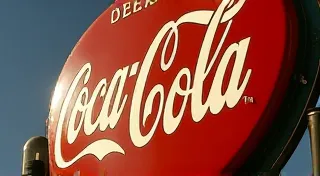The History of Porcelain Enamel Signs: A Durable Advertising Legacy
Vintage advertising signs are a captivating piece of Americana, and among the most enduring and sought-after are those crafted using the porcelain enamel process. These signs, often vibrant and detailed, offer a glimpse into a bygone era of marketing and design. But what exactly is porcelain enamel, and how did it become such a significant medium for advertising?
What is Porcelain Enamel?
Porcelain enamel, often simply called "porcelainized steel," isn’s porcelain in the traditional sense. It’s a fusion of glass and steel. A layer of powdered glass, mixed with pigments for color, is applied to a steel base – typically sheet steel. This mixture is then fired at extremely high temperatures (typically between 750-900°C / 1382-1652°F) in a kiln. The intense heat melts the glass, permanently bonding it to the steel. The result is a remarkably durable, weather-resistant surface.

Early Development and Adoption
While the process of fusing glass to metal dates back centuries, the modern industrial process for producing porcelain enamel was developed in the mid-19th century, primarily in Europe. It quickly gained traction as a cost-effective and durable surface for various applications, including cookware, bathroom fixtures, and, crucially, advertising. The initial move from paper-based advertising was driven by the realization that the elements would quickly destroy lithographic signs. Imagine the impact of years of rain and sun – paper simply couldn't withstand it.
The early adoption of porcelain enamel for advertising signs was gradual. Initially, lithographic signs (printed on paper or cardboard) were more common. However, the limitations of paper – its susceptibility to the elements – spurred manufacturers to seek a more resilient option. Porcelain enamel offered precisely that: a sign that could withstand decades of exposure to sun, rain, and snow. Early adopters were often progressive businesses looking to project an image of longevity and reliability.
The Rise of Porcelain Enamel Advertising
By the late 1800s and early 1900s, porcelain enamel signs began to appear increasingly in the American landscape, advertising everything from Coca-Cola and Ford automobiles to farm equipment and household goods. The vibrant colors and detailed artwork made these signs eye-catching and effective. The durability meant businesses could invest in a sign that would last. The advertising landscape itself changed; suddenly, businesses could reach potential customers far beyond their immediate location, creating a national brand identity. Some companies, seeking to evoke a sense of nostalgic charm and classic appeal, realized that mimicking the look and feel of earlier advertising – even in porcelain enamel – could resonate powerfully with consumers. The goal was often to capture the visual language of a simpler time, a strategy that continues to influence advertising design today.
Manufacturing Techniques & Evolution
The manufacturing process itself evolved over time. Early porcelain enamel signs often utilized a technique called "hand-painted" enameling, where skilled artisans would painstakingly hand-paint the designs onto the steel base. This was a labor-intensive process, resulting in signs that are now highly prized by collectors. The artistry involved in these hand-painted signs is truly remarkable, showcasing a level of skill rarely seen today. The artistry of these signs reflects a different time – a time when a company's reputation was intimately tied to the quality and craftsmanship of its advertising materials. The legacy of those skilled artisans lives on in the value collectors place on these rare pieces.
As technology advanced, mechanical processes, including screen printing and eventually roller printing, were implemented. These methods allowed for greater efficiency and reproducibility, leading to mass production. While some might argue that the standardization brought about by these mass-production techniques sacrificed some of the unique character of earlier, hand-painted signs, the result was an expansion of advertising's reach and a greater variety of products being promoted. It’s fascinating to consider how the shift to mechanical printing mirrored the broader industrial revolution, bringing increased output but often sacrificing some of the original artistic flair. The value placed on identifying the production method is a key factor for sign collectors. Collectors are often captivated by the subtle variations that can reveal the hand of the artist, even in mechanically produced signs, making careful examination a crucial part of the hobby. If you've ever wondered about the impact of mass production on the aesthetic of these iconic pieces, exploring the subtle differences between hand-painted and mechanically printed signs can be illuminating.

Popular Brands and Sign Types
Several companies were dominant players in the porcelain enamel advertising sign industry. Some of the most recognized include:
- Whitall & Tancred: A pioneer in the industry, known for their high-quality signs.
- Sto Mfg. Co.: Another major producer, known for its distinctive signage.
- Signcraft: A significant manufacturer, especially in the mid-20th century.
The types of signs produced were incredibly diverse, ranging from large "litho-enamels" (thin porcelain layers on a lithographed steel base) to thicker, more robust signs. Specific product categories like automotive, beverage, and farm equipment were particularly well represented. The regional variations in advertising are also significant, and exploring collecting signs by region reveals fascinating stories about local brands and advertising trends. It’s a rich and rewarding area of study for any sign enthusiast. The visual history of a region can be read like a map, with the advertising signs acting as markers of economic development and cultural identity.
Why Collectors Value Porcelain Enamel Signs
Today, porcelain enamel advertising signs remain highly sought after by collectors for several reasons:
- Durability: Many of these signs have survived for over a century, a testament to the process's robustness.
- Aesthetics: The vibrant colors and distinctive artwork represent a unique era in advertising design.
- Historical Significance: They offer a tangible link to the past, representing businesses, products, and a specific time in American history.
- Rarity: Some signs, particularly those from smaller or less common brands, are exceedingly rare, driving up their value. Understanding the nuances of production methods, regional variations, and the rarity of certain designs is crucial for any serious collector. For those seeking the most prized examples, rare and unusual advertising signs are the ultimate goal – the "holy grails" of sign collecting. Sometimes, even seemingly minor variations in color or design can drastically increase a sign's value, highlighting the importance of meticulous research and careful observation.
Beyond simply admiring the signs, many collectors are interested in understanding the psychology behind their design. The colors, fonts, and imagery were all carefully chosen to evoke specific emotions and associations in the viewer. Exploring the psychology of advertising signs reveals how much thought and effort went into crafting these seemingly simple advertisements. They weren’t just selling a product; they were selling a lifestyle, an aspiration, a promise. For instance, the choice of a particular font might have been influenced by current trends in typography, or the use of a specific color palette might have been intended to associate a product with feelings of luxury or trustworthiness.
The automotive industry, in particular, heavily relied on porcelain enamel signs to promote their vehicles and build brand loyalty. The iconic designs and bold typography created a powerful image of speed, freedom, and progress. The value of identifying & valuing Texaco advertising signs, for example, demonstrates the intense interest in specific brands and the complexities of authentication and appraisal within the collecting world. Certain brands cultivated a specific image, and their advertising signs became powerful symbols of that identity, contributing to their overall market success.

The Future of Porcelain Enamel Sign Collecting
As with any collectible, the market for porcelain enamel signs is constantly evolving. New discoveries are made, values fluctuate, and trends emerge. The fleeting nature of trends and changing tastes can significantly impact the value of certain signs, making it crucial for collectors to stay informed about current market conditions. The appearance of a particularly well-preserved example of a rare sign can sometimes trigger a surge in demand, while a shift in popular taste can lead to a decline in the value of previously sought-after pieces. The appeal of these signs also extends beyond their monetary value, offering a tangible connection to a bygone era and a fascinating glimpse into the history of American advertising.
Furthermore, the preservation of these signs is becoming increasingly important, as they represent a unique and irreplaceable part of our cultural heritage. The materials used in their construction are susceptible to deterioration over time, and the signs are vulnerable to damage from the elements. The challenges of restoring and preserving these signs are considerable, requiring specialized knowledge and careful attention to detail. The ongoing efforts to document and protect these signs ensure that future generations will be able to appreciate their beauty and historical significance.
Finally, the resurgence of interest in vintage and retro aesthetics suggests a bright future for porcelain enamel sign collecting. As consumers increasingly seek out products and experiences that evoke a sense of nostalgia and authenticity, the appeal of these signs is likely to continue to grow. The enduring charm and historical significance of these remarkable objects ensure that they will remain treasured possessions for collectors and enthusiasts for many years to come.





